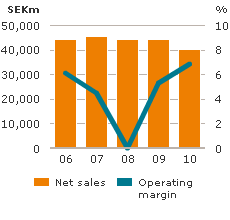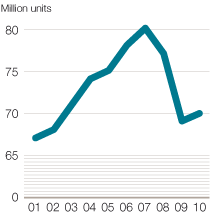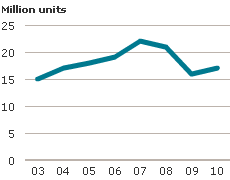During the year, Electrolux continued to strengthen its position in the segment for built-in products through initiatives including the launch of an entirely new series of innovative, energy-efficient products under the AEG brand. Profitability in the region improved through new cost savings and a better mix.
The market
The European market for household appliances was worth approximately SEK 205 billion in 2010, of which Eastern Europe accounted for about 18%. Demand increased somewhat during the year, although from a low level. The increase was primarily due to stronger growth in Eastern Europe, driven mainly by Russia, and to greater demand in major Western European economies such as Germany and France. Demand for vacuum cleaners increased marginally in most regions and segments.
The market for built-in appliances continued to show strong growth. Interest continued to be strong in energy- and water-efficient appliances.
The diversity of countries that comprise the European market has contributed to a wide variation in consumer behavior and numerous manufacturers, brands and retailers. The European market is a highly complex market in which the low consolidation among manufacturers has led to overcapacity. This has resulted in downward pressure on prices for a considerable time. In recent years, prices have stabilized somewhat.
Retailers
The European market features many small, local and independent retail chains that focus on electrical and electronic products as well as kitchen interiors. Strong organic growth for retailers in recent years has inhibited consolidation. Vacuum cleaners are sold through the same channels as household appliances and through superstores.
Kitchen specialists currently account for approximately 25% of sales of household appliances in Western Europe. The corresponding figure for Germany and Italy is approximately 40%.
Since the proportion of consumers that use the Internet before deciding to make a purchase is growing rapidly, manufacturers’ websites are becoming increasingly important as a tool for convincing consumers. The brand must be displayed correctly and consumers provided with the answers they require.
The Group’s position
During the year, Electrolux strengthened its position in the built-in segment, primarily in the German market. During the fourth quarter, a completely new range of innovative built-in appliances in the premium segment was launched under the AEG brand in Germany and Austria. The launch continues in other markets in 2011. At the end of the year, a new range of energy-efficient premium vacuum cleaners, manufactured using up to 70% recycled plastic, was launched.
A positive trend in terms of the mix and lower costs due to previous and new cost-cutting measures have contributed to improved operating income.
Eastern Europe accounts for approximately 20% of Group sales of appliances in Europe and about 15% of sales of vacuum cleaners. Lower sales volumes in 2010 were primarily the result of the bankruptcy of the German Quelle chain, one of the Group´s largest retail partners, at the end of 2009. In this period, however, sales volumes under the Electrolux brand showed a positive trend and the new partnership with IKEA developed positively.





